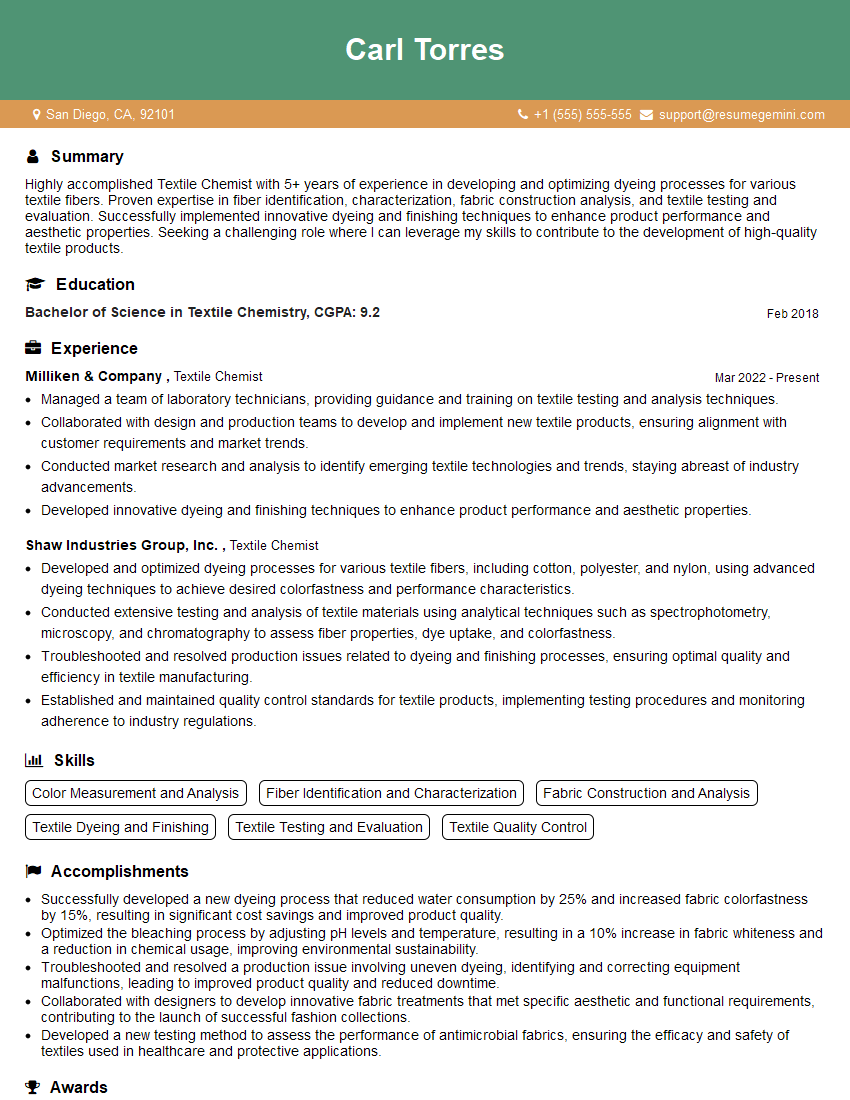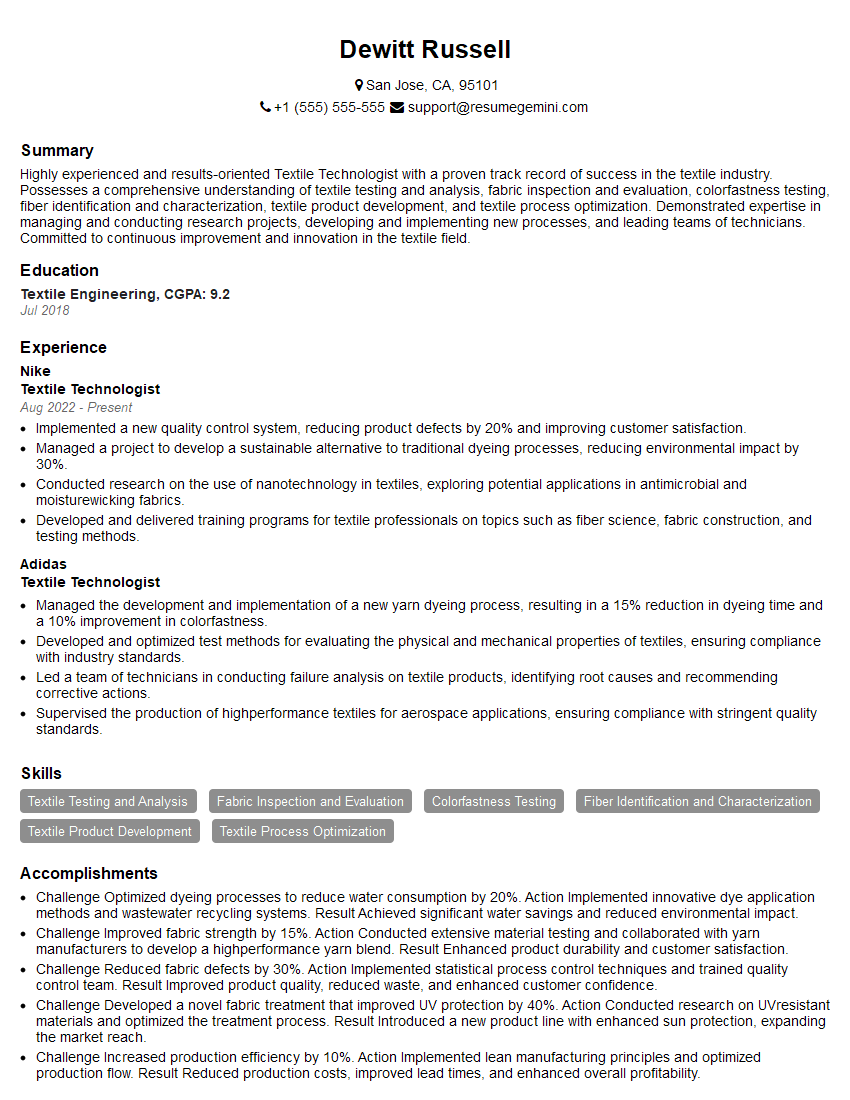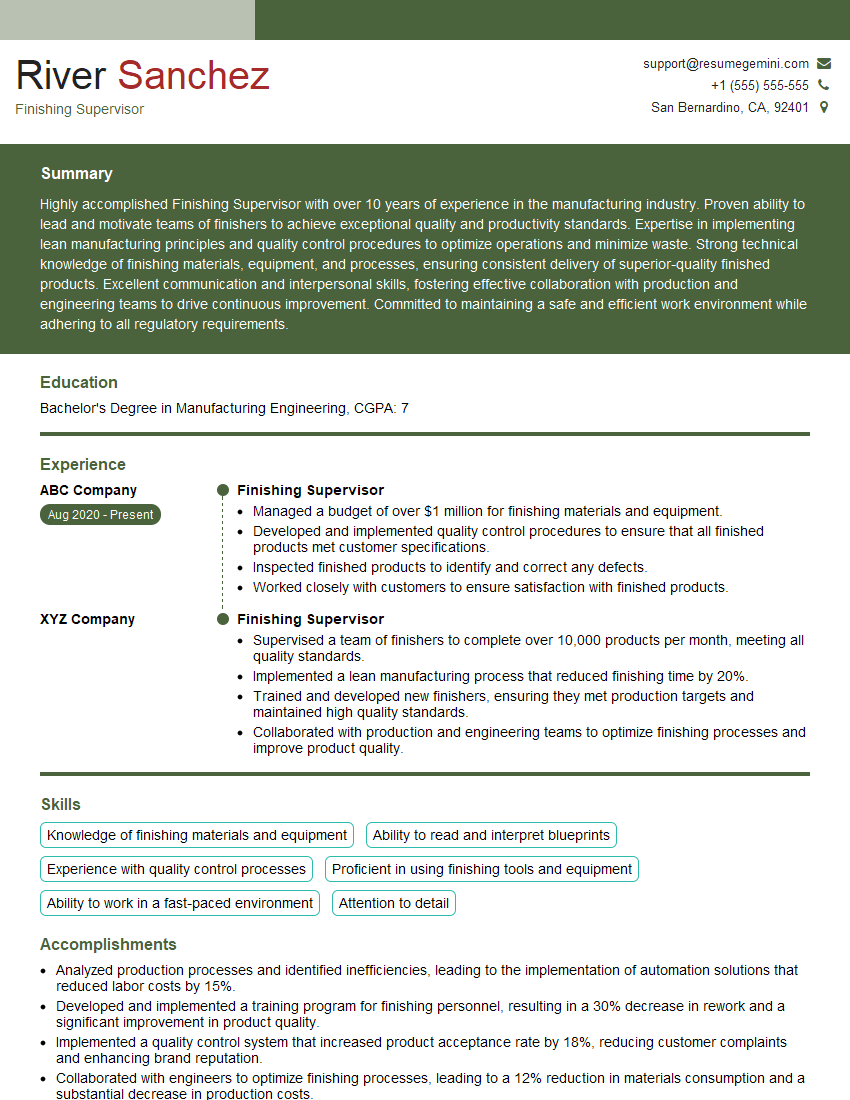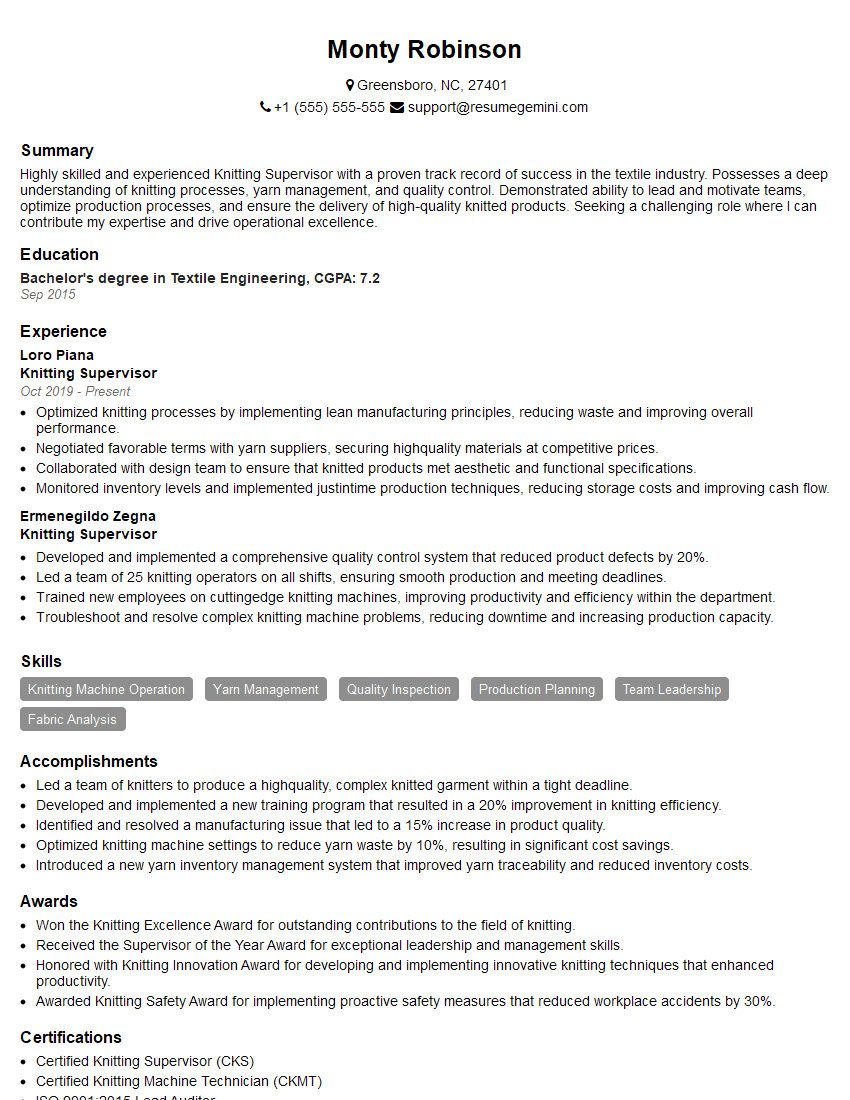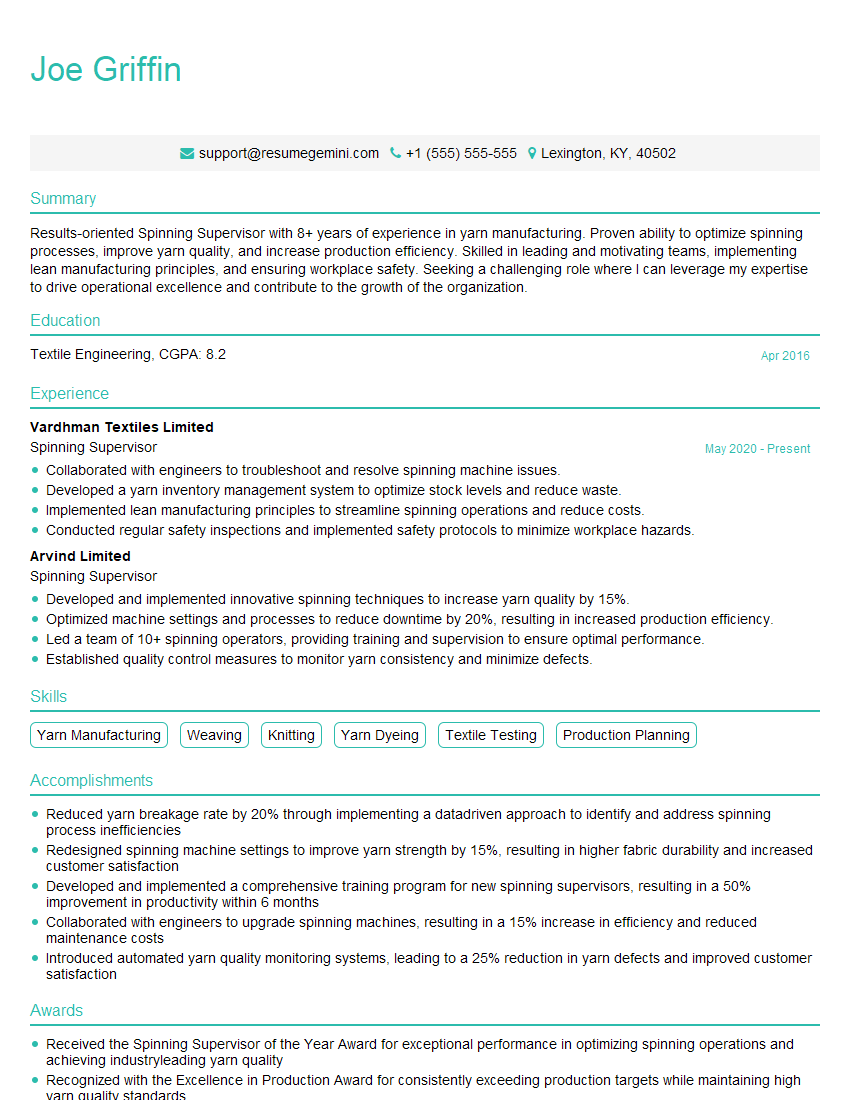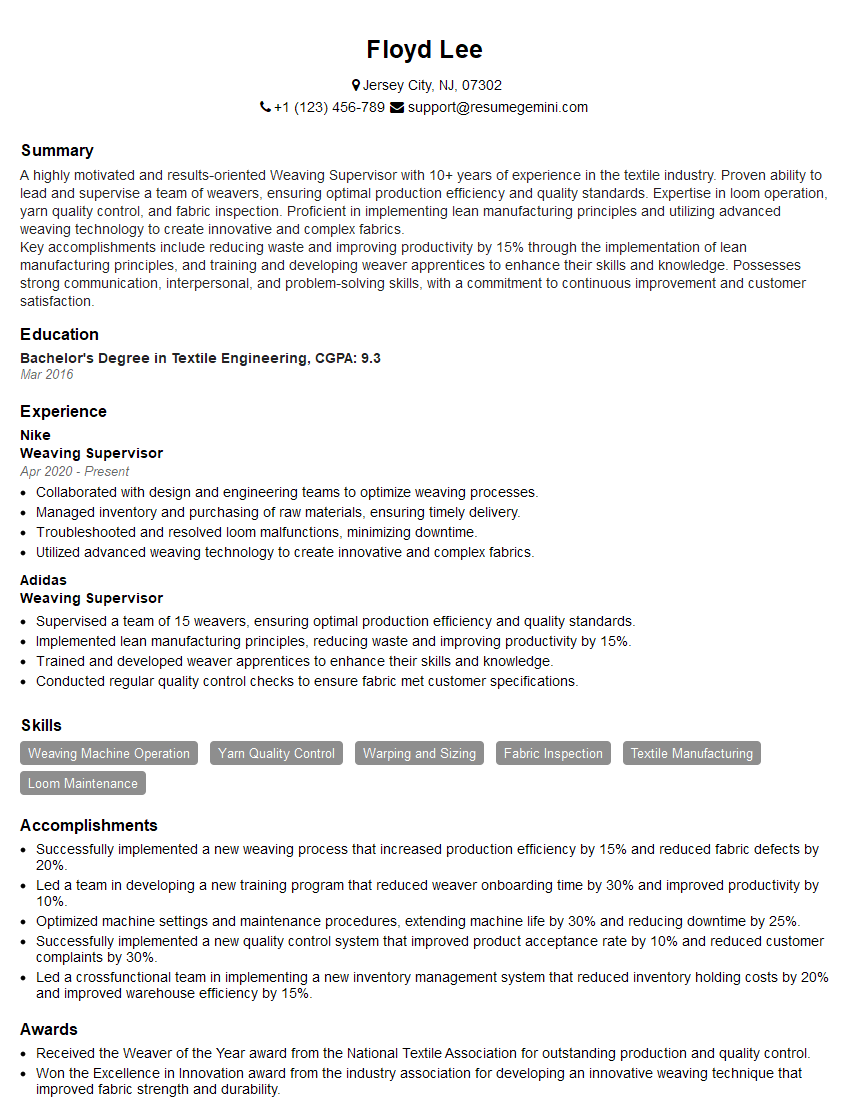The thought of an interview can be nerve-wracking, but the right preparation can make all the difference. Explore this comprehensive guide to Warp and Weft Yarn Production interview questions and gain the confidence you need to showcase your abilities and secure the role.
Questions Asked in Warp and Weft Yarn Production Interview
Q 1. Explain the difference between warp and weft yarns.
Warp and weft yarns are the two fundamental components of woven fabric, differing significantly in their role and characteristics. Think of it like building a brick wall: warp yarns are the vertical bricks, providing the foundation and strength, while weft yarns are the horizontal bricks, filling in the gaps and creating the fabric’s texture and pattern.
Warp yarns are the lengthwise yarns that run parallel to the selvedge (the finished edge of the fabric). They are under significant tension during weaving and need to be strong and relatively uniform to withstand this stress. They are often wound onto a large beam called a warp beam.
Weft yarns, also known as filling yarns, are the yarns that run across the width of the fabric, interlacing with the warp yarns to create the woven structure. They are generally less tightly controlled than warp yarns in terms of tension. Weft yarns are typically fed from a shuttle, a pirn, or a weft supply system.
In essence, warp yarns provide the structural integrity, while weft yarns contribute to the fabric’s design, texture, and drape.
Q 2. Describe the process of yarn preparation for weaving.
Yarn preparation for weaving is a crucial step that significantly impacts the final fabric quality. It involves several stages aimed at ensuring the yarns are ready for the high-speed and precise movements required during weaving.
- Winding: Individual yarn packages (e.g., cones, bobbins) are wound onto larger packages such as warper beams (for warp yarns) or pirns (for weft yarns).
- Sizing (for warp yarns): Warp yarns, especially those made of natural fibers like cotton or linen, are often sized. Sizing is a process of applying a starch-based or synthetic coating to the yarns. This improves their strength, abrasion resistance, and reduces yarn breakage during weaving.
- Warping: This is the process of winding the sized warp yarns onto a large beam called a warp beam, arranging the yarns precisely according to the desired fabric width and structure.
- Drawing-in: The warp yarns from the warp beam are then carefully drawn through the heddles (vertical frames with slits to raise and lower warp yarns) and reeds (parallel wires that space the warp yarns at even distances) of the loom.
- Weft Preparation: Weft yarns are wound onto pirns (small cylindrical packages) or other weft supply systems suitable for the weaving machine.
Proper yarn preparation ensures smooth weaving, prevents yarn breakage, and contributes to a high-quality, consistent final fabric.
Q 3. What are the common types of warp and weft yarns used in textile production?
The choice of warp and weft yarns depends heavily on the desired fabric properties, the weaving method, and the cost considerations. Here are some common types:
- Warp Yarns: High-tenacity yarns like polyester, nylon, cotton (mercerized for added strength), linen (for specific applications)
- Weft Yarns: Cotton, wool, silk, polyester, viscose, blends of various fibers. The weft yarn can have a more varied texture and structure.
For example, a high-quality cotton shirting might use mercerized cotton for the warp for strength and luster, and a softer, more textured cotton for the weft to create the desired hand-feel. Conversely, a durable denim fabric might utilize a strong, sturdy cotton warp and a slightly thicker, textured cotton weft.
Q 4. How do you identify yarn defects?
Identifying yarn defects is essential for maintaining quality control. Defects can arise at any stage of yarn production and can significantly impact the final fabric’s appearance and performance. They can be identified through visual inspection, and sometimes with specialized instruments.
- Neppiness: Small knots or clusters of entangled fibers.
- Slubs: Thick places in the yarn.
- Thin places: Areas where the yarn is thinner than normal.
- Broken ends: Literally, broken strands in the yarn.
- Hairiness/fuzziness: Excessive short fibers protruding from the yarn surface.
- Color variation: Differences in the yarn’s color.
Experienced textile technicians use a combination of visual inspection aided by magnifying glasses, along with automated inspection systems in larger production settings, to detect these defects.
Q 5. Explain the concept of yarn count and its significance.
Yarn count, or yarn number, is a measure of the fineness or coarseness of a yarn. It represents the linear density of the yarn, indicating how many units of length (e.g., meters, yards) weigh a specific unit of mass (e.g., grams, pounds). Different systems exist, such as the English system (denier or counts per inch) and the metric system (tex).
Significance: Yarn count is crucial because it directly influences the fabric’s properties. Finer yarns (higher yarn count) produce smoother, more delicate fabrics, while coarser yarns (lower yarn count) result in thicker, heavier fabrics. Understanding yarn count is essential for selecting appropriate yarns for different applications, determining fabric costs, and controlling the quality of the final product.
Q 6. Describe the different types of weaving machines.
Weaving machines come in various types, each with its own advantages and limitations depending on the desired fabric construction and production scale.
- Conventional Looms (Shuttle Looms): These are traditional looms that use a shuttle to carry the weft yarn across the warp yarns. They are suitable for smaller-scale operations and are well-suited to simpler weaves, yet are slower than other options.
- Air-Jet Looms: These use jets of air to propel the weft yarn across the warp, allowing for much faster weaving speeds.
- Water-Jet Looms: Instead of air, jets of water propel the weft yarn, enabling even faster speeds and suitability for delicate yarns.
- Rapier Looms: Utilize grippers or rapiers to carry the weft yarn across the warp. They are versatile and can handle a wide range of yarns.
- Projectile Looms: The weft yarn is propelled across the warp by a projectile, achieving high speeds suitable for large-scale production.
The choice of weaving machine depends on factors such as production volume, yarn type, fabric design complexity, and budget.
Q 7. What are the common problems encountered during warping?
Warping, the process of preparing the warp yarns for weaving, can encounter several problems that can lead to production delays and fabric defects.
- Yarn Breakage: This is a common problem, often caused by tension variations, yarn defects, or faulty warping machinery. It can lead to the need for time-consuming repairs and can introduce inconsistencies in the fabric.
- Uneven Tension: Inconsistent tension among the warp yarns leads to uneven fabric structure and possible fabric defects like bowing or slanting.
- Warp Beam Defects: Problems with the warp beam itself, such as uneven winding or warping of the beam, can cause tension issues and yarn breakage.
- End-to-End Variations: The warp beam is not perfectly uniform across its width can cause undesirable variations in fabric density.
- Creases and Knots: These are defects that develop during the winding process, and can disrupt the warp and even lead to yarn breakage.
Regular maintenance of warping machinery, careful yarn handling, and proper tension control are crucial in preventing these problems.
Q 8. How do you troubleshoot yarn breakage during weaving?
Yarn breakage during weaving is a common problem that can significantly impact productivity and fabric quality. Troubleshooting involves a systematic approach, examining the yarn itself, the weaving machine’s setup, and the weaving process.
- Inspect the Yarn: Begin by carefully examining the broken yarn. Look for signs of weakness, such as thin spots, neps (small knots), or excessive fuzziness. These imperfections indicate flaws in the spinning process or fiber quality. A microscope can be very helpful here.
- Check Machine Settings: Incorrect tension settings on the loom are a major culprit. If the warp tension is too high, the yarn will snap; too low and it might tangle. Check the reed’s condition for damage or misalignment, which can also cause breakage. The heddle frames need to operate smoothly, without any snags.
- Assess Weaving Conditions: Environmental factors play a role. High humidity can weaken some yarns, making them more prone to breakage. Similarly, excessive dryness can lead to static buildup, increasing the risk of breakage. The presence of any debris or foreign objects in the weaving machine must be thoroughly investigated.
- Systematic Elimination: Replace the section of warp yarn, adjust the tension, and carefully monitor the process. If the problem persists, move to a different section of warp to determine if the issue is localized or widespread. This approach helps pinpoint the root cause quickly.
For instance, I once encountered frequent yarn breakage in a high-speed weaving plant. After a thorough investigation, we discovered a slight misalignment in the reed, causing excessive friction and ultimately leading to yarn failure. A simple adjustment resolved the problem, significantly increasing productivity.
Q 9. What are the factors affecting yarn strength and elongation?
Yarn strength and elongation, crucial properties for weaving, are influenced by several interrelated factors.
- Fiber Properties: The inherent strength and elasticity of the individual fibers (cotton, wool, polyester, etc.) are fundamental. Longer fibers generally create stronger yarns.
- Spinning Process: The spinning method directly impacts yarn structure. Ring-spun yarns, known for their strength and evenness, differ from open-end spun yarns, which are often less strong but more productive.
- Twist: The amount of twist introduced during spinning significantly affects yarn strength and elongation. More twist generally increases strength but decreases elongation, while less twist enhances elongation but reduces strength. Finding the right balance is key.
- Yarn Linear Density: Thicker yarns (lower linear density) tend to be stronger, but may be less flexible. Thin yarns (higher linear density) are more flexible, but less strong.
- Yarn Hairiness: Excessive hairiness (loose fibers protruding from the yarn surface) can weaken the yarn and lead to increased breakage.
- Environmental Factors: Humidity and temperature fluctuations can affect fiber strength and yarn properties. Excessive heat can weaken some fibers.
Think of it like a rope; a rope made from thick, strong fibers tightly twisted together will be much stronger and less prone to stretching than a rope made from thin, weak fibers loosely twisted.
Q 10. Explain the role of sizing in warp yarn preparation.
Sizing is a crucial pre-weaving treatment for warp yarns. It involves applying a starch-based or synthetic sizing solution to the warp yarns to improve their strength, abrasion resistance, and weaving performance.
- Increased Strength: Sizing acts as a protective layer, reducing yarn breakage during the high-tension weaving process.
- Improved Abrasion Resistance: It safeguards the yarn from the friction it encounters during weaving, which is particularly important for finer yarns.
- Enhanced Weaving Efficiency: A properly sized warp yarn reduces shedding, prevents slippage, and allows for faster weaving speeds.
- Better Yarn Appearance: Sizing can help improve the evenness and appearance of the woven fabric.
Different types of sizes exist for various fibers and weaving requirements, and the amount of size applied depends on the yarn characteristics and the desired fabric quality. For example, linen yarns often require more sizing than cotton yarns because of their inherent strength.
Q 11. Describe the different types of yarn twisting methods.
Several methods exist for twisting yarns, each impacting the yarn’s properties.
- Ring Spinning: This classic method uses a rotating spindle to twist fibers together, producing high-strength yarns with good uniformity.
- Rotor Spinning: A rotor spins the fibers at high speed, creating a yarn quickly and economically. However, the resulting yarn is typically less strong than ring-spun yarn.
- Air-Jet Spinning: Air jets twist the fibers, offering a faster and more versatile approach, though it can lead to variation in yarn strength.
- Friction Spinning: The twisting mechanism is based on friction between fibers, resulting in open-end yarns that can be less strong but are often suitable for certain applications.
The choice of twisting method depends on factors such as the desired yarn quality, production costs, and the type of fiber being processed. For instance, high-quality garments often use ring-spun yarns for their strength and evenness, whereas less demanding applications might employ rotor-spun yarns for their cost-effectiveness.
Q 12. How do you ensure consistent yarn quality throughout the production process?
Consistent yarn quality is paramount in textile production. Maintaining it involves a multi-faceted strategy:
- Fiber Selection: Choose high-quality fibers with consistent characteristics. Thorough fiber testing is essential to ensure uniformity.
- Process Monitoring: Implement real-time monitoring of spinning parameters (twist, speed, tension) using sensors and automated systems. This enables immediate adjustments to maintain consistency.
- Quality Control Checks: Regularly conduct quality tests, such as strength, elongation, hairiness, and evenness, at different stages of production using standardized methods. Regular cleaning and maintenance are vital to reduce variation.
- Preventive Maintenance: Maintain and calibrate the spinning machinery to prevent problems and ensure its consistent performance. A well-maintained machine minimizes variation.
- Operator Training: Skilled operators are critical in maintaining consistency. Training and clear procedures significantly improve results.
- Statistical Process Control (SPC): Use statistical methods to monitor variations and identify potential problems before they cause significant deviations in quality.
For instance, implementing an SPC system in a yarn spinning plant allowed us to quickly identify and address variations in yarn evenness, leading to a significant reduction in fabric defects and waste. It provides the feedback needed to ensure ongoing improvement.
Q 13. What are the different methods for testing yarn properties?
Various methods are used to test yarn properties. These tests provide crucial data for quality control and process optimization:
- Tensile Strength Test: Measures the force needed to break a yarn sample, indicating its strength.
- Elongation Test: Determines the yarn’s ability to stretch before breaking, an indication of its elasticity.
- Hairiness Test: Assesses the amount of loose fibers protruding from the yarn surface, impacting yarn appearance and strength.
- Evenness Test: Evaluates the uniformity of the yarn’s thickness along its length. Uneven yarns are more likely to break.
- Twist Test: Measures the amount of twist per unit length, influencing yarn strength and structure.
- Yarn Count Test: Determines the yarn’s linear density, essential for calculating material requirements.
Many of these tests are performed using specialized instruments. Results are analyzed and compared to established standards to verify that the yarn meets the required specifications.
Q 14. Explain the importance of maintaining proper tension during weaving.
Maintaining proper tension during weaving is essential for fabric quality and weaving efficiency.
- Warp Tension: Consistent warp tension is crucial. Too much tension can lead to yarn breakage, while too little can result in poor fabric structure and misalignment.
- Weft Tension: Proper weft tension ensures even fabric density and prevents puckering or slackness. This tension must be controlled independently of warp tension and monitored to remain consistent.
- Balanced Tension: Maintaining the right balance between warp and weft tension is vital. Imbalances can distort the fabric, creating defects.
- Tension Control Devices: Modern looms incorporate sophisticated tension control devices. These use sensors and actuators to precisely manage tension across the entire weaving process.
- Impact of Improper Tension: Uneven tension can lead to various weaving defects including broken ends, slubs (thick areas), and inconsistent fabric density.
Imagine trying to weave a tapestry with unevenly taut threads. The result would be a misshapen, uneven piece. The same is true in the industrial process; consistent tension is vital to produce high-quality woven fabric.
Q 15. How do you calculate yarn production efficiency?
Calculating yarn production efficiency involves assessing how effectively resources are utilized to produce yarn. It’s not a single metric but rather a combination of factors, often expressed as a percentage. A common approach involves comparing the actual output against the planned or potential output.
Key Metrics:
- Production Rate: Measured in kilograms or meters of yarn produced per hour or per day. This helps assess the speed and effectiveness of the spinning process.
- Machine Uptime: The percentage of time the machinery is actively producing yarn versus downtime due to maintenance, repairs, or breaks. High uptime is crucial for efficiency.
- Waste Rate: The percentage of raw materials lost during the production process due to breakage, imperfections, or other factors. Minimizing waste is critical.
- Yield: The ratio of finished yarn weight to the initial weight of raw fibers. A higher yield indicates less waste.
Calculation Example: Let’s say a spinning mill planned to produce 1000 kg of yarn in a day but only produced 900 kg due to machine downtime. The production efficiency would be (900 kg / 1000 kg) * 100% = 90%. This indicates areas for improvement, perhaps through preventative maintenance to reduce downtime.
In practice, a comprehensive efficiency analysis also considers factors like labor costs, energy consumption, and quality control measures to provide a holistic view.
Career Expert Tips:
- Ace those interviews! Prepare effectively by reviewing the Top 50 Most Common Interview Questions on ResumeGemini.
- Navigate your job search with confidence! Explore a wide range of Career Tips on ResumeGemini. Learn about common challenges and recommendations to overcome them.
- Craft the perfect resume! Master the Art of Resume Writing with ResumeGemini’s guide. Showcase your unique qualifications and achievements effectively.
- Don’t miss out on holiday savings! Build your dream resume with ResumeGemini’s ATS optimized templates.
Q 16. Describe the different types of yarn dyeing methods.
Yarn dyeing methods are broadly classified into two categories: fiber dyeing (before spinning) and yarn dyeing (after spinning). Each category features several techniques:
- Fiber Dyeing: This method involves dyeing the individual fibers *before* they are spun into yarn. This results in even color distribution throughout the yarn, and the color is very resistant to fading. Common methods include:
- Solution Dyeing: Dye is added directly to the polymer solution before fiber formation, resulting in exceptionally colorfast yarns.
- Stock Dyeing: Dye is added to the loose fibers before spinning.
- Yarn Dyeing: This method involves dyeing the yarn *after* it has been spun. It’s often chosen for its versatility in creating variegated effects and its cost-effectiveness for smaller batches. Techniques include:
- Package Dyeing: Yarn packages are immersed in dye baths.
- Beam Dyeing: Yarn is dyed on large beams.
- Jet Dyeing: High-pressure jets circulate the dye through the yarn.
- Space Dyeing: Creates variegated effects by applying multiple colors to the yarn during dyeing.
The choice of dyeing method depends on the desired colorfastness, cost, and the desired aesthetic effect. For example, solution dyeing is ideal for high-quality, colorfast apparel, while space dyeing is preferred for unique fashion fabrics.
Q 17. What are the environmental considerations in yarn production?
Environmental considerations in yarn production are paramount. The industry faces challenges related to water consumption, wastewater discharge, energy use, and waste generation.
- Water Pollution: Dyeing processes often release wastewater containing heavy metals and chemicals. Proper treatment and responsible disposal are essential. Closed-loop systems, which recycle and reuse water, are increasingly important.
- Water Consumption: Significant amounts of water are used in various stages, particularly dyeing and finishing. Efficient water management techniques, including recirculation and water-saving dyeing technologies, are necessary.
- Energy Consumption: The manufacturing process, especially spinning and dyeing, consumes large amounts of energy. Adopting energy-efficient machinery and renewable energy sources can reduce the environmental footprint.
- Waste Management: Waste generation from fiber trimming, yarn imperfections, and packaging materials needs careful management. Recycling and waste reduction programs are crucial.
- Air Emissions: Some processes release volatile organic compounds (VOCs) into the atmosphere. Air pollution control systems are necessary to reduce these emissions.
Sustainable practices, such as using eco-friendly dyes and chemicals, implementing cleaner production technologies, and adopting circular economy principles, are becoming increasingly important to mitigate the environmental impact of yarn production.
Q 18. Explain the concept of yarn shrinkage.
Yarn shrinkage refers to the reduction in the length or dimensions of a yarn after it’s subjected to certain processes like washing, drying, or finishing. It’s caused by the relaxation of fibers or the loss of moisture.
Types of Shrinkage:
- Relaxation Shrinkage: Occurs due to the relaxation of stresses built up during the spinning process.
- Felting Shrinkage: Primarily seen in wool yarns, this happens due to the entanglement and interlacing of fibers in wet conditions.
Factors Affecting Shrinkage:
- Fiber type: Wool and other animal fibers tend to shrink more than synthetic fibers.
- Yarn construction: Tightly twisted yarns tend to shrink less than loosely twisted yarns.
- Finishing processes: Treatments like heat setting or chemical finishing can affect shrinkage.
Managing Shrinkage: Pre-shrinking techniques, like heat setting, are employed to minimize shrinkage in the finished fabric. Understanding the shrinkage properties of different yarns is crucial for accurate fabric design and production.
Q 19. How do you manage inventory in yarn production?
Effective inventory management in yarn production is crucial for ensuring smooth operations and minimizing waste. It involves balancing supply and demand, optimizing storage, and minimizing stockouts or overstocking.
Key Strategies:
- Demand Forecasting: Accurate prediction of future yarn requirements based on sales data, market trends, and customer orders.
- Just-in-Time (JIT) Inventory: Minimizing inventory levels by receiving materials and components only when needed. This reduces storage costs and minimizes the risk of obsolescence.
- Inventory Tracking System: Using software or a database to track yarn quantities, locations, and expiry dates. This provides real-time visibility into inventory levels.
- Quality Control: Regular inspection of yarn stocks to ensure quality and identify potential defects.
- FIFO (First-In, First-Out): A stock rotation method ensuring older yarn is used first to minimize the risk of spoilage or degradation.
Effective inventory management reduces costs, minimizes waste, improves efficiency, and enhances customer satisfaction by ensuring timely delivery of orders. Using a combination of these strategies tailored to the specific production environment leads to optimal inventory levels.
Q 20. What are the safety protocols in yarn production?
Safety protocols in yarn production are essential to protect workers from potential hazards. These protocols should be comprehensive and cover all aspects of the production process.
Key Safety Measures:
- Machine Guarding: Ensuring all machinery has appropriate guards to prevent accidental contact with moving parts.
- Personal Protective Equipment (PPE): Providing and enforcing the use of PPE, such as safety glasses, gloves, hearing protection, and dust masks, to protect workers from various hazards.
- Emergency Procedures: Establishing clear emergency procedures, including fire safety plans and first-aid protocols, and conducting regular training drills.
- Ergonomics: Designing workstations and work processes to minimize physical strain and repetitive stress injuries.
- Housekeeping: Maintaining a clean and organized work environment to prevent accidents and slips.
- Chemical Safety: Implementing strict protocols for handling and storing chemicals, including proper labeling, ventilation, and emergency response procedures.
- Noise Control: Implementing measures to reduce noise levels, such as using noise-dampening materials and providing hearing protection.
Regular safety inspections, employee training, and adherence to safety regulations are vital for creating a safe working environment in yarn production. A proactive approach to safety minimizes accidents, reduces worker injuries, and improves overall productivity.
Q 21. Describe your experience with different types of weaving structures.
My experience encompasses a wide range of weaving structures, from basic plain weaves to more complex and intricate designs. Understanding these structures is crucial for achieving the desired fabric properties – drape, texture, strength, and aesthetic appeal.
Examples of Weaving Structures:
- Plain Weave: The simplest structure, where the warp and weft yarns interlace in an over-under pattern. It’s known for its strength and versatility.
- Twill Weave: Creates diagonal lines by having the weft yarns float over two or more warp yarns before interlacing. It offers durability and a distinct texture.
- Satin Weave: Characterized by long floats of warp or weft yarns, creating a smooth, lustrous surface. It’s often used for high-quality fabrics.
- Jacquard Weave: Allows for complex and intricate designs with multiple colors and patterns using a specialized loom. This is used for elaborate tapestries and decorative fabrics.
- Pile Weave: Creates a raised surface of loops or cut pile, resulting in fabrics like velvet, corduroy, and terry cloth.
My expertise involves not only identifying different weaves but also understanding how variations in yarn count, twist, and material affect the final fabric characteristics. For instance, using a finer yarn in a satin weave will result in a smoother and more lustrous fabric compared to using a coarser yarn.
Q 22. Explain the difference between single and plied yarns.
The core difference between single and plied yarns lies in their construction. A single yarn is a continuous strand of fibers twisted together. Think of it like a single rope made from individual strands. It’s relatively simple to produce but can be less strong and more prone to twisting or unraveling.
A plied yarn, on the other hand, is created by twisting together two or more single yarns. Imagine braiding multiple ropes together to create a stronger, thicker rope. This process significantly increases the yarn’s strength, durability, and reduces its tendency to twist or pill. Plied yarns are often preferred for applications requiring higher tensile strength, like carpets or heavier-weight fabrics.
- Single Yarn Example: A fine cotton yarn used in a lightweight summer dress.
- Plied Yarn Example: A thicker wool yarn used for knitting a durable sweater.
Q 23. How do you handle customer complaints regarding yarn quality?
Handling customer complaints regarding yarn quality is crucial for maintaining customer satisfaction and brand reputation. My approach is systematic and focuses on thorough investigation and resolution. First, I gather all the necessary information, including the specific complaint, lot number of the yarn, and any supporting evidence (photos, samples). Then, I conduct a detailed analysis of the yarn, possibly using lab testing to identify the root cause of the issue – was it a problem with fiber quality, the spinning process, or something else?
Once the cause is identified, I work to develop a solution that addresses the problem at its source, preventing similar occurrences in the future. This may involve adjusting parameters in the spinning process, implementing stricter quality control checks, or even sourcing different raw materials. Throughout the process, I maintain open communication with the customer, providing updates and offering appropriate compensation or replacements as needed. The goal is not only to resolve the immediate issue but also to reinforce the customer’s trust in our products and services.
Q 24. What are the different types of fiber used in yarn production?
The variety of fibers used in yarn production is vast, each lending unique properties to the final product. They can be broadly categorized into natural and synthetic fibers.
- Natural Fibers: These are derived from plants or animals. Examples include:
- Cotton: Known for its softness, breathability, and absorbency.
- Wool: Provides warmth, elasticity, and moisture-wicking properties.
- Silk: Luxurious, smooth, and lustrous, renowned for its delicate drape.
- Linen: Strong, durable, and naturally wrinkle-resistant.
- Hemp: Sustainable, strong, and durable.
- Synthetic Fibers: These are created artificially through chemical processes. Examples include:
- Polyester: Durable, wrinkle-resistant, and retains its shape well.
- Nylon: Strong, elastic, and resistant to abrasion.
- Acrylic: Soft, warm, and relatively inexpensive, often used as a wool substitute.
- Rayon: Soft, drapes well, and can absorb moisture.
The choice of fiber depends heavily on the intended application of the yarn and the desired properties of the final textile.
Q 25. Describe your experience with yarn quality control systems.
My experience with yarn quality control systems is extensive, encompassing all stages of the production process. I’ve worked with and implemented various systems, from basic visual inspections to advanced automated systems employing optical sensors and data analysis. A typical system would include:
- Raw Material Inspection: Checking fiber quality (length, strength, cleanliness) upon arrival.
- In-Process Monitoring: Regular checks during spinning, including yarn count, evenness, and strength.
- Finished Yarn Testing: Testing for various properties like tensile strength, elongation, and pilling resistance.
- Statistical Process Control (SPC): Using statistical methods to monitor the process and identify any deviations from established standards.
- Data Analysis: Analyzing data to identify trends, root causes of defects, and opportunities for improvement.
Effective quality control is not just about detecting defects; it’s about preventing them. Proactive measures, including regular maintenance of equipment and thorough employee training, are equally important.
Q 26. How do you optimize yarn production processes for cost-effectiveness?
Optimizing yarn production for cost-effectiveness requires a holistic approach, focusing on efficiency gains throughout the entire process. This involves:
- Efficient Raw Material Sourcing: Negotiating favorable prices with reliable suppliers and minimizing waste.
- Process Optimization: Improving machine efficiency, reducing downtime, and minimizing material waste during spinning and winding.
- Energy Efficiency: Implementing measures to reduce energy consumption in the manufacturing process.
- Waste Reduction: Minimizing waste generation throughout the entire process and recycling where possible.
- Inventory Management: Optimizing inventory levels to reduce storage costs and minimize the risk of obsolescence.
- Automation: Implementing automation where appropriate to reduce labor costs and increase productivity.
Continuous monitoring and improvement are crucial. By regularly reviewing production data and identifying bottlenecks, we can pinpoint areas for optimization and implement targeted improvements to reduce overall production costs.
Q 27. What are the latest advancements in warp and weft yarn production technology?
The warp and weft yarn production industry is constantly evolving, driven by the demand for higher efficiency, improved quality, and sustainable practices. Some of the latest advancements include:
- Advanced Spinning Technologies: Developments in rotor spinning, air-jet spinning, and ring spinning have led to faster speeds, improved yarn quality, and reduced energy consumption.
- Automation and Robotics: Increased automation in tasks like yarn winding, inspection, and packaging, enhancing efficiency and reducing labor costs.
- Smart Manufacturing and IoT: The integration of sensors, data analytics, and cloud computing allows for real-time monitoring, predictive maintenance, and process optimization.
- Sustainable Practices: Growing emphasis on environmentally friendly practices, such as using recycled materials, reducing water and energy consumption, and minimizing waste.
- Nanotechnology Applications: Exploring the use of nanotechnology to enhance yarn properties, such as strength, durability, and stain resistance.
These advancements are transforming the industry, driving innovation, and improving the overall sustainability and efficiency of yarn production.
Q 28. Describe a time you had to solve a complex problem related to yarn production.
One particularly challenging situation involved a significant increase in yarn breakage during the spinning process. The initial troubleshooting focused on machine maintenance, but the problem persisted. We meticulously analyzed data from various parameters: machine settings, fiber quality, environmental conditions, even the humidity levels in the factory.
Eventually, through detailed data analysis, we discovered a subtle correlation between yarn breakage and minor fluctuations in the ambient temperature. It turned out that these temperature fluctuations were causing slight variations in fiber tension, leading to increased breakage. We addressed this by installing a more sophisticated climate control system in the spinning area. The problem was solved; yarn breakage rates dropped dramatically, and production efficiency improved significantly. This experience reinforced the importance of thorough data analysis and systematic troubleshooting in resolving complex production issues.
Key Topics to Learn for Warp and Weft Yarn Production Interview
- Yarn Properties and Selection: Understanding fiber types, yarn counts, and their impact on fabric properties. Consider how different yarn choices affect the final product’s quality, drape, and durability.
- Warping and Beaming Processes: Familiarize yourself with different warping methods (e.g., sectional, direct) and their applications. Be prepared to discuss troubleshooting common warping issues and ensuring optimal warp beam preparation for efficient weaving.
- Weft Insertion Techniques: Master the principles of weft insertion methods like shuttle weaving, projectile weaving, air-jet weaving, and rapier weaving. Understand the advantages and disadvantages of each technique and their suitability for various fabric types.
- Weaving Machine Operation and Maintenance: Gain a strong understanding of loom operation, including settings, adjustments, and preventative maintenance. Be prepared to discuss troubleshooting common weaving machine malfunctions and optimizing production efficiency.
- Quality Control and Inspection: Learn about quality control measures in yarn production, including testing methods and defect identification. Understanding how to identify and address weaving defects is crucial for maintaining high standards.
- Production Planning and Scheduling: Develop a comprehension of production planning, scheduling, and inventory management within a yarn production facility. Understanding how to optimize production flow and minimize downtime is vital.
- Health and Safety Regulations: Demonstrate awareness of relevant health and safety regulations in textile manufacturing environments. This includes understanding and adhering to safe operating procedures for machinery and handling materials.
Next Steps
Mastering Warp and Weft Yarn Production opens doors to rewarding careers in the textile industry, offering opportunities for growth and specialization. A strong understanding of these processes is highly valued by employers. To significantly improve your job prospects, invest time in creating an ATS-friendly resume that highlights your skills and experience effectively. ResumeGemini is a trusted resource that can help you build a professional and impactful resume. Examples of resumes tailored to Warp and Weft Yarn Production are available to guide you through the process.
Explore more articles
Users Rating of Our Blogs
Share Your Experience
We value your feedback! Please rate our content and share your thoughts (optional).
What Readers Say About Our Blog
Hi, I have something for you and recorded a quick Loom video to show the kind of value I can bring to you.
Even if we don’t work together, I’m confident you’ll take away something valuable and learn a few new ideas.
Here’s the link: https://bit.ly/loom-video-daniel
Would love your thoughts after watching!
– Daniel
This was kind of a unique content I found around the specialized skills. Very helpful questions and good detailed answers.
Very Helpful blog, thank you Interviewgemini team.
